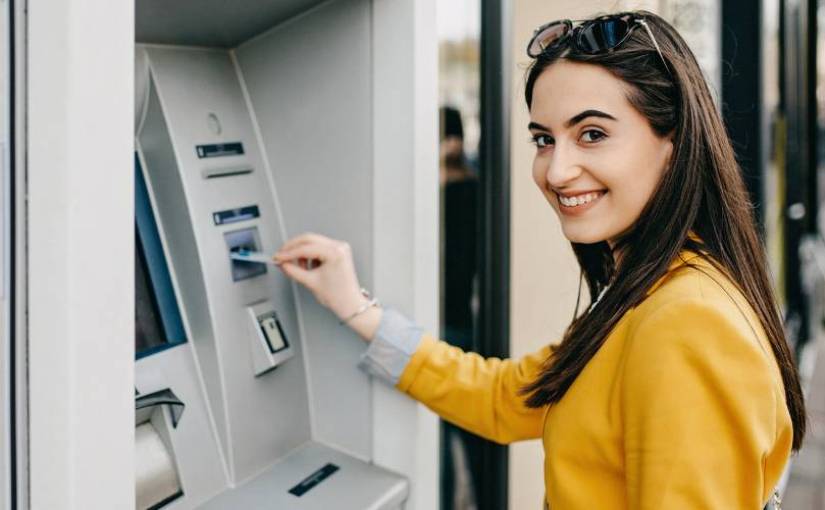In the world of modern banking, technology plays a crucial role in keeping our money safe and secure. One such groundbreaking technology is blockchain.
Now, you might wonder, what is this “blockchain” thing? Think of it as a digital lockbox that nobody can open without a special key. Blockchain is like a chain of these lockboxes, linked to keep everyone’s transactions safe.
ATMs, or Automated Teller Machines, are those handy little devices that let us withdraw money, check our account balance, and even deposit cash without going inside the bank.
They have become an essential part of our daily lives, providing us with quick and easy access to our funds. But, just like any other technology, ATMs face security challenges too.
In this article, we’ll explore how blockchain technology can work its magic to make ATMs even more secure, protecting our hard-earned money and giving us peace of mind while managing our finances.
So, let’s dive into the fascinating world of blockchain and its potential to revolutionize ATM security!
The Current State of ATM Security
ATMs have been the target of various security challenges over the years, making exploring innovative solutions to protect users and their funds essential. Some of the key security challenges include:
- Card Skimming: Criminals install tiny devices on ATM card readers to steal card information during transactions. This allows them to clone the cards and access users’ bank accounts.
- Malware Attacks: Hackers create malicious software that infects ATMs, enabling them to steal sensitive data or manipulate the ATM’s functionality for fraud.
- Physical Breaches: ATMs located in less secure areas can be physically tampered with or broken into, leading to unauthorized access and theft.
- Limited Authentication Methods: Traditional ATMs often rely on basic PIN authentication, which can be vulnerable to brute-force attacks and social engineering.
Blockchain technology offers promising solutions for ATM security. By leveraging its features, such as decentralization and cryptographic hashing, blockchain can:
- Prevent card skimming by encrypting data securely and transparently, reducing the risk of unauthorized access.
- Protect against malware attacks through its tamper-resistant nature, making it difficult for hackers to compromise the system.
- Enhance physical security by enabling secure peer-to-peer transactions, eliminating the need for intermediaries, and minimizing physical breach risks.
- Introduce advanced authentication methods, such as biometrics or digital signatures, to bolster security and prevent unauthorized access.
Blockchain’s adoption will revolutionize the future, providing a robust and efficient defense against evolving threats in the digital age.
Understanding Blockchain Technology
Blockchain is like a digital, unchangeable ledger that records transactions super securely. Let’s explore how it works and why it’s so amazing!
1. What is Blockchain, and How It Works?
Imagine a chain of blocks, where each block is a bunch of transactions bundled together. These transactions could be anything, like money transfers or document records.
Now, instead of having one person or company in charge of this chain, everyone in the network has a copy of it. So, if someone tries to tamper with a block, everyone else can see it and won’t let it happen!
2. Components of a Blockchain
- Blocks: Each block contains a bunch of transactions, just like pages in a book. When a block is full, a new one is created, linking to the previous one, forming a chain.
- Cryptographic Hashing: This is like a unique fingerprint for each block. It takes all the data in the block and turns it into a fixed-size string of characters. If anything in the block changes, the fingerprint also alerts everyone that something’s fishy.
- Decentralization: Unlike a single company holding the records, blockchain is spread across many computers, called nodes. This decentralization makes it super tough for hackers to mess with the system.
3. Ensuring Transparency, Immutability, and Security
- Transparency: Since everyone has a copy of the blockchain, all transactions are visible to everyone. It builds trust and reduces the chances of fraud.
- Immutability: Once a block is added to the chain, it cannot be altered or deleted. This permanent record ensures the integrity of the data.
- Security: With cryptographic hashing and decentralization, blockchain becomes highly secure. Hacking one computer won’t change the entire chain, making it super safe.
Blockchain technology is like a team of watchdogs guarding a treasure chest, ensuring no one sneaks in to mess with your data!
Key Features of Blockchain for ATM Security
Blockchain transforms ATM security with decentralization and cryptographic hashing, mitigating vulnerabilities. Resilient and tamper-resistant, it safeguards users’ funds effectively.
- Addressing Vulnerabilities: Blockchain technology can bolster ATM security by eliminating central points of control, reducing the risk of cyberattacks, and ensuring tamper-resistant data. Its decentralized nature spreads the transaction data across multiple nodes, making it incredibly difficult for hackers to target a single point of failure.
- Decentralization for Resilience: ATMs don’t rely on a single entity for data storage or processing with blockchain. Decentralization ensures that even if one ATM is compromised, the rest of the network remains secure, minimizing the impact of potential breaches and providing a robust defense against attacks.
- Cryptographic Hashing for Protection: Blockchain employs cryptographic hashing to convert transaction data into unique codes. This process ensures that any tampering with the data would change the hash, alerting the network to unauthorized changes and maintaining the integrity of the ATM’s transaction records.
Incorporating blockchain into ATM systems fortifies their security, creating a distributed and tamper-proof network that can withstand evolving threats and safeguard users’ funds with utmost confidence.
Blockchain-Based Identity and Authentication
Blockchain technology offers significant advancements in user identity verification at ATMs, providing enhanced security and reliability compared to traditional methods.
1. Enhanced Identity Verification
Blockchain enables a tamper-proof digital identity record, making it more reliable and secure. When a user’s identity is verified, the information is encrypted within the blockchain, reducing the risk of data breaches.
This ensures that only authorized users can access their accounts, providing an added layer of protection against identity-related fraud.
2. Digital Signatures for Authentication
The concept of digital signatures acts as unique fingerprints for each transaction. It establishes authenticity and prevents unauthorized access to user accounts.
By creating an unforgeable link between the user’s identity and actions, digital signatures bolster authentication, minimizing the chances of fraudulent activities and ensuring the integrity of transactions.
3. Decentralized Identity Solutions
With decentralized identity solutions, users retain control over their personal information. Instead of storing sensitive data in a central database prone to breaches, blockchain’s decentralized nature distributes the identity-related data across multiple nodes.
This reduces the risk of identity theft and fraud, as there is no single point of failure, making it exceedingly difficult for malicious actors to compromise the system and access sensitive information.
Secure and Transparent Transactions
Blockchain technology revolutionizes ATM security, ensuring secure and tamper-resistant transactions through its decentralized architecture. The system becomes highly resistant to data alteration and unauthorized access by linking transaction data in blocks through cryptographic hashing.
Smart contracts play a pivotal role in automating transaction processes, verifying user identity and account details before executing fund transfers without intermediaries, and minimizing errors and delays.
Real-time transaction tracking enhances transparency, enabling users to monitor progress and trace fund flow, bolstering accountability, and deterring fraudulent activities. With these key features, blockchain elevates ATM security, instilling confidence and trust in the system’s reliability.
Mitigating ATM Fraud and Attacks
You may have heard about the risks of ATM fraud, like card skimming, which can leave us concerned about using ATMs. However, there’s a technology that can significantly improve ATM security – blockchain!
Blockchain is like a digital fortress that shields us from common fraud techniques. When we use an ATM equipped with blockchain, our transaction data gets encrypted and spread across the network. This decentralization makes it incredibly difficult for hackers to tamper with or intercept our data during transactions.
Without a central control point, blockchain thwarts card skimming attempts, making it a robust defense mechanism.
Moreover, blockchain uses advanced encryption to safeguard sensitive data. Even if hackers gain access to the data, they’ll find it nearly impossible to decode, ensuring our information stays safe from data breaches and identity theft.
Another benefit is protection against DDoS attacks. Blockchain’s distributed nature means there’s no single target, making it resilient to these malicious attacks. As a result, our ATM systems can remain operational and secure even during intense cyber threats.
By leveraging these impressive features, blockchain emerges as a trustworthy ally in the battle against ATM fraud, providing us with a secure and worry-free banking experience.
Enhancing ATM Network Security
Blockchain technology has the potential to significantly enhance the security of the entire ATM network through its unique features and mechanisms:
1. Strengthening ATM Network Security
- Blockchain’s decentralized architecture reduces the risk of single points of failure, making it harder for attackers to compromise the entire ATM network.
- Transaction data stored in blocks and linked through cryptographic hashing ensures tamper-resistant records, maintaining the integrity of the network.
2. Consensus Mechanisms for Network Integrity
- Consensus mechanisms, like Proof of Work or Proof of Stake, ensure that all network nodes agree on the validity of transactions, preventing fraudulent activities.
- By achieving consensus, blockchain establishes a trustful and transparent environment for all participants, bolstering the security of the ATM network.
3. Benefits of Reducing Intermediary Dependencies
- Blockchain eliminates the need for intermediaries, like banks, in ATM transactions, reducing associated fees and delays.
- This direct peer-to-peer interaction streamlines the process and minimizes potential points of vulnerability, further enhancing security.
Incorporating blockchain into the ATM network provides a robust and secure infrastructure, ensuring that users can confidently conduct transactions, knowing their funds are well-protected from threats.
Regulatory and Compliance Considerations
1. Potential Compliance Challenges
Implementing blockchain technology in ATMs may encounter regulatory challenges, as this emerging technology disrupts traditional financial systems. Existing regulations might not fully account for blockchain’s decentralized nature and could require updates to address security and consumer protection concerns.
2. Impact of Data Privacy Laws on Blockchain-Based Systems
Data privacy laws play a crucial role in shaping blockchain adoption. While blockchain offers transparency and immutability, some privacy laws demand the right to be forgotten or data erased.
Striking a balance between transparency and data protection is essential, as compliance with privacy regulations is vital for blockchain’s successful implementation in ATMs.
3. Examples of Successful Blockchain Adoption in the Financial Sector
The financial sector has embraced blockchain technology to improve security and efficiency. For instance, Ripple’s cross-border payment system enables faster and more cost-effective transactions.
J.P. Morgan’s Quorum, now Consensys Quorum, enhances confidentiality and data sharing for financial institutions. These examples showcase how blockchain can revolutionize financial services while complying with applicable regulations.
Real-World Applications and Case Studies
Blockchain technology has paved the way for becoming a formidable tool in fintech development. One exemplary case study is the partnership between Mastercard and Island Pay, which deployed a blockchain-based prepaid card system in the Bahamas.
This application showcases how blockchain can be leveraged to streamline cross-border transactions using digital currency, achieving faster and more cost-effective outcomes while ensuring compliance and transparency.
In another case study, the National Bank of Egypt implemented blockchain technology to enhance remittance services. By collaborating with Ripple, the bank significantly reduced transaction times from several days to a matter of seconds.
This improvement positively impacted customer experience, reduced transaction fees, and streamlined the cross-border payment process.
Both examples demonstrate how blockchain’s decentralized and transparent nature can revolutionize financial systems, providing faster, more efficient, and secure transactions that benefit consumers and financial institutions alike.
These real-world examples emphasize how blockchain reshapes financial systems and how investing in fintech courses and bootcamps can empower individuals to become skilled professionals in this rapidly evolving field.
Real-World Applications and Case Studies
Blockchain technology has paved the way for becoming a formidable tool in fintech development. One exemplary case study is the partnership between Mastercard and Island Pay, which deployed a blockchain-based prepaid card system in the Bahamas.
This application showcases how blockchain can be leveraged to streamline cross-border transactions using digital currency, achieving faster and more cost-effective outcomes while ensuring compliance and transparency.
In another case study, the National Bank of Egypt implemented blockchain technology to enhance remittance services. By collaborating with Ripple, the bank significantly reduced transaction times from several days to a matter of seconds.
This improvement positively impacted customer experience, reduced transaction fees, and streamlined the cross-border payment process.
Both examples demonstrate how blockchain’s decentralized and transparent nature can revolutionize financial systems, providing faster, more efficient, and secure transactions that benefit consumers and financial institutions alike.
These real-world examples emphasize how blockchain reshapes financial systems and how investing in fintech courses and bootcamps can empower individuals to become skilled professionals in this rapidly evolving field.
Challenges and Future Outlook
Blockchain technology can potentially revolutionize ATM security, including Bitcoin withdrawal, but several challenges must be addressed for successful implementation.
However, the future prospects of blockchain-based ATM security are promising, with ongoing developments and advancements in the technology driving its widespread adoption in the financial industry.
Let’s explore the current limitations, future outlook, and potential advancements in blockchain technology that could further enhance ATM security.
1. Current Limitations and Challenges of Implementing Blockchain in ATMs
While blockchain shows great promise in revolutionizing ATM security, some challenges persist. First, scalability remains an issue, as blockchain networks might struggle to handle the high transaction volume of ATM networks efficiently.
Second, regulatory compliance poses hurdles, as current laws may not fully accommodate decentralized systems. Additionally, transitioning from traditional ATM infrastructure to blockchain-based systems requires substantial investment and careful planning.
2. Future Prospects of Blockchain-Based ATM Security
Despite the challenges, the future outlook for blockchain-based ATM security is promising. As technology matures, scalability solutions, such as layer-two solutions, are expected to improve network efficiency.
Regulatory frameworks will likely evolve to embrace blockchain innovations, fostering widespread adoption in the financial industry. Increased collaboration between financial institutions and blockchain developers will also drive advancements in ATM security.
3. Potential Advancements in Blockchain Technology for Enhanced ATM Security
Blockchain technology is constantly evolving, with ongoing research and development to enhance security. Advancements in quantum-resistant cryptography will bolster resistance against future threats.
Interoperability between various blockchain networks will enable seamless data exchange, improving overall network efficiency and facilitating cross-border transactions. Moreover, advancements in privacy-preserving techniques, like zero-knowledge proofs, will give users more control over their data without compromising security.
As these advancements continue to unfold, blockchain-based ATM security is poised to offer unparalleled protection, creating a safer and more trustworthy financial landscape for users worldwide.
Conclusion
Blockchain technology holds the transformative potential to revolutionize ATM security, addressing vulnerabilities and bolstering trust in financial transactions.
By leveraging decentralization and cryptographic hashing, blockchain ensures secure and tamper-resistant transactions, combatting standard ATM fraud techniques like card skimming and data breaches.
Smart contracts automate transaction processes, streamlining operations while reducing intermediary dependencies, leading to faster and more efficient transactions.
Furthermore, blockchain’s distributed nature fortifies the ATM network against DDoS attacks and single points of failure, ensuring uninterrupted services and safeguarding user funds.
Real-world applications, like the partnership between Mastercard and Island Pay, demonstrate the practical benefits of blockchain in facilitating secure cross-border transactions.
The future outlook for blockchain-based ATM security is promising, with advancements in scalability, privacy, and regulatory compliance expected to drive broader adoption.
As quantum-resistant cryptography and interoperability features continue to evolve, blockchain technology is poised to offer unparalleled protection, making the financial industry safer and more robust.
In light of these significant advancements, adopting blockchain technology in the financial industry becomes imperative. Embracing blockchain’s potential will strengthen ATM security and enhance overall financial services, bringing about transparency, efficiency, and improved user experiences.
By integrating blockchain, financial institutions can position themselves at the forefront of innovation, leading toward a more secure and trust-driven future in banking and beyond.
Featured Image Credit: Provided by the Author; Pexels; Thank you!


















